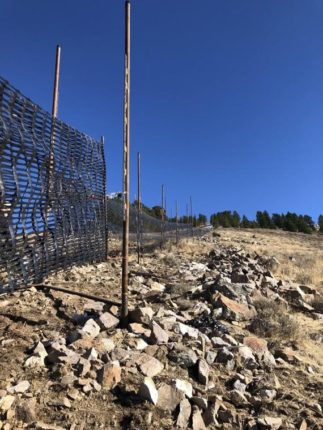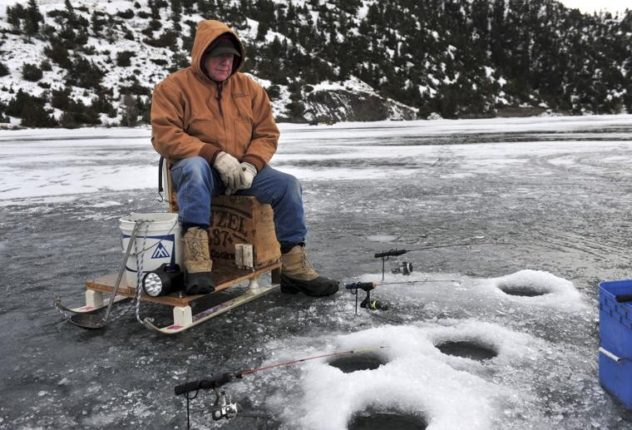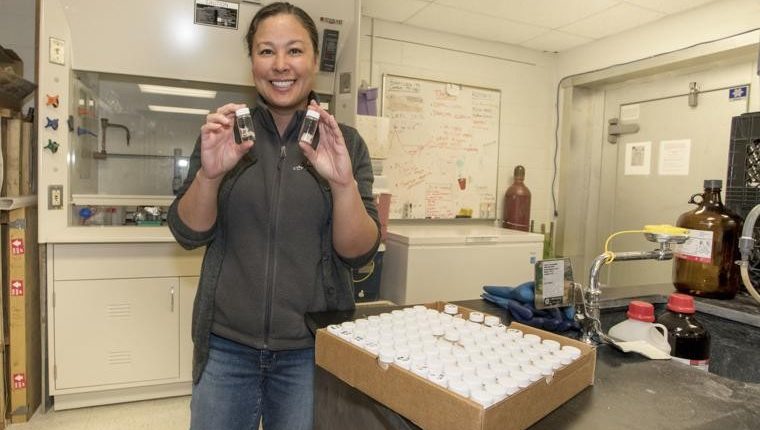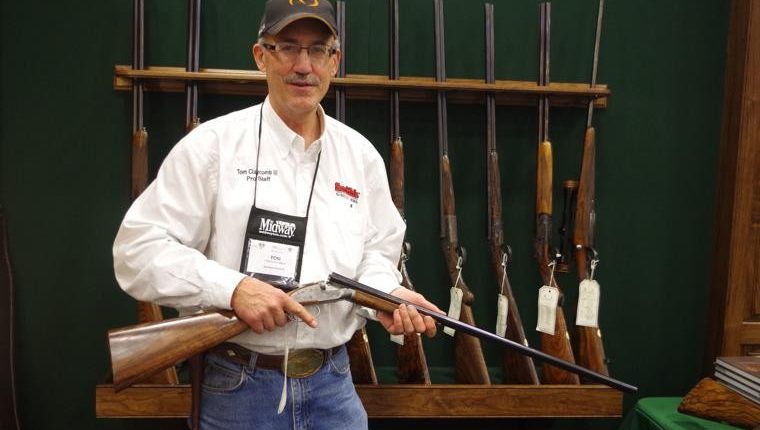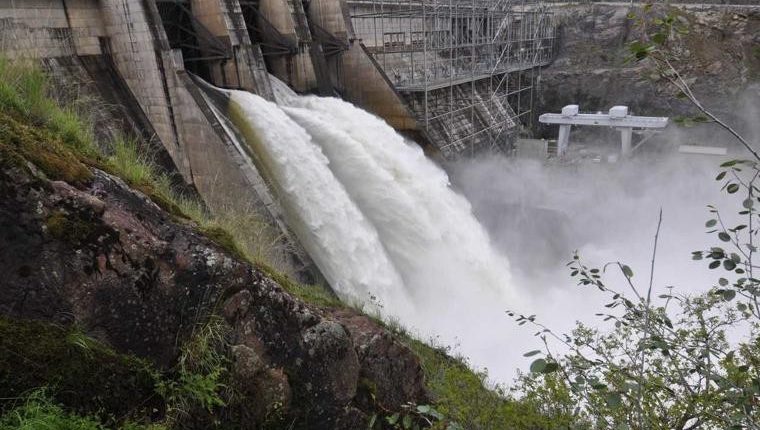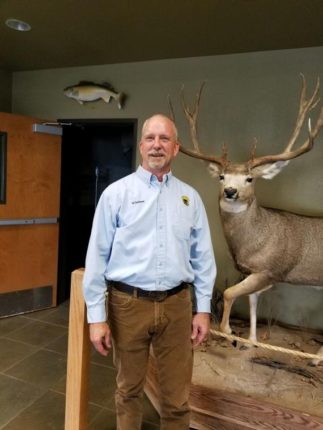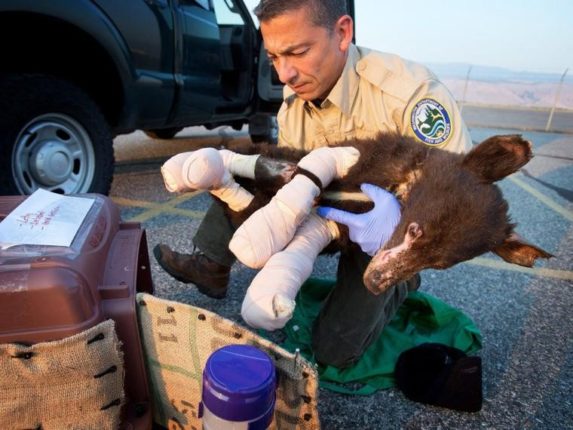If I remember correctly, I was about 9 years old when I saw my mother’s old skis at my grandfather Andersen’s house in Blackfoot and took them home to learn to ski. A pair of bamboo poles came with the skis, and I didn’t have to buy ski boots because t…
Category: Outdoors
Pebble Creek replaces snow fence, maintains lifts in off-season
INKOM — Skiers and snowboarders at Pebble Creek Ski Area will have a bit more room to turn, and potentially better snow cover, when they take runs on Sunshine Ridge this season.
They should also notice a smoother ride up the ski area’s three lifts.
Mike Rodriguez, lift supervisor at Pebble Creek, said the ski area has replaced the short, wooden fence along Sunshine Ridge with a taller, new fence designed to capture snow. He said the drifts that accumulate will be spread throughout the run to bolster the base.
Pebble Creek has also conducted maintenance on its ski lifts, he said. Rodriguez is one of four employees at the ski area who work year-round, making improvements during the summer.
Rodriguez said the new fence is adjustable and can be extended up to 15 feet high.
“It has the ability to keep moving up higher as snow fills in,” Rodriguez said. “As storms and new snow come in, we will slowly bump it up so it can continue to catch snow for us.”
The new fence, made of steel and plastic, will be installed in 20, 100-foot sections with breaks in between them, enabling skiers to move from Sunshine Ridge to the adjacent run, Sun Bowl. Rodriguez said the fence has also been moved over about 20 to 40 feet, depending on the spot, to widen the Sunshine Ridge run. Rodriguez said the cost of the project was about $6,000.
“The old buck-and-rail fence would quickly get buried in snow, and it would be ineffective for catching snow that was being blown by the wind or a storm,” Rodriguez said. “If we’re able to catch snow, it won’t blow away, and we’ll be able to distribute the piles of the drifts onto the run, making it more adequate for skiing and boarding.”
Rodriguez said the lift maintenance included replacing 60 sheaves, which are the wheels on the towers that move the lift cable.
Rodriguez and the staff cleared some brush from within Sun Bowl. They also completed a large recycling and cleanup project, selling a snowcat, a front-end loader and a six-wheel Army truck for either reuse or salvage. He said they also recycled 58,000 pounds of aluminum and steel — including cable spools, metal racks, lift components and old snowmobiles — that had left in storage at the ski area for for more than 30 years.
Pebble Creek has implemented a new computer system to operate its ticketing, season passes, cash registers and other systems.
For the ski area’s 70th anniversary this season, a local artist, Chelsy Harten, has also produced a new trail map.
Rodriguez said the ski area has a staff of about 60 employees for the season. Pebble Creek is already open for the season.
Reeling in the fun with ice fishing
It may seem a little crazy to leave the comforts of your home for the purpose of dangling a jig or a worm through a small hole in the ice, and there are those who worry about the safety of ice fishing, especially when you hear occasional stories of people falling through the ice. However, if you prepare properly and follow a few basic safety tips, ice fishing can truly be a fun and safe way to spend a day outdoors during the winter.
Ice fishing safety
Here are some things to keep in mind.
- Typically, 4 inches of good, hard ice is required to support an individual, and about 6 inches is necessary to support an ATV or snow machine. To check ice depth, use an auger to cut a hole near the bank and again several feet away from the bank. You will find that ice depths can vary to some degree across the same body of water.
- Don’t assume that snow-covered ice is safe ice. In fact, ice covered with snow for a prolonged period can actually become warmed due to the insulating effect of snow. And rain-on-snow events (typical in early winter and spring) will cause rapid melting of ice around the shoreline and near any hole cut in the ice.
- Some anglers will carry a 20 to 30 foot rope as a precaution in case someone falls through the ice, and there are even hand-held ice picks you can use to help you crawl out of a hole. These picks are connected with a rope or cord so that you can “string” the picks through your coat sleeves, leaving the picks to dangle by your hands for easy access.
- Probably the single most important safety rule to follow (besides checking ice thickness) happens to also be a law. Do not cut holes in the ice greater than 10 inches across. Holes can freeze over incompletely — even become hidden with snow — and an unsuspecting angler can fall through. The exception to this hole-size rule is for those who dipnet for cisco on Bear Lake.
- A real key for enjoying ice fishing is buying good clothing that protects and insulates. You may recall the ad campaign that says something like “There is no such thing as bad weather, just bad gear.” And let’s not forget that old but so wise saying from everyone’s mom, “dress in layers.” Portable heaters and quick-setup portable shelters sold at your favorite sporting goods store are wonderful, too, for staying warm out on the ice.
- Drink plenty of water and hot drinks (which offer both hydration and warmth), even if you don’t feel thirsty. Being well-hydrated helps your body maintain a safe core temperature.
Ice fishing gear
Ice fishing requires special ice fishing equipment. An ice fishing pole is very short, and there is no casting involved. You just let the bait or lure sink below the hole; sometimes you have to add a sinker. You can use worms, stinky bait (sometimes garlic scents work really well) and lures such as jigs. Remember that only artificial lures are allowed on some bodies of water — so check the regulations before you go.
There are buckets you can take to sit on — some even come with padded seats — and they help hold your stuff when you are getting on or off the ice. Camp chairs are fine, too. You will need slotted spoons for removing ice from the holes. Because you can have up to five poles per person when ice fishing on many Idaho waters, pole holders that sit right on the ice come in handy.
A sled for pulling your gear out onto the ice is also a must. I have tried using the sleds our family takes on the hill, but they don’t hold very much and your items can slide off. You can actually buy sleds with high sides that are perfect for holding everything— including your auger.
Lastly, don’t forget your fishing license for those anglers over 14, and take the time to review the regulations before heading to your favorite ice fishing spot.
Ice fishing with kids
Above all, when the kids have had enough, then it is time to go. You want them to leave with happy memories about their special day with you, and more importantly, they will want to join you next time!
Make the fishing adventure about them and for them. That means most of your time may be spent keeping bait on hooks, removing ice chunks from the hole and keeping their bodies full of hot chocolate — even if it means you don’t get to fish very much or at all.
Pack good snacks, hot beverages and water (remember staying hydrated helps you stay warm), and extra clothing and socks. A portable heater or a portable ice fishing shelter makes things extra comfortable — for you, too.
Popular spots for ice fishing
There is no shortage of places to ice fish in southeast Idaho. Some of Southeast Idaho’s popular locations include:
- American Falls Reservoir: This is a great place to catch some big trout and even perch through the ice. Remember, this is a large body of water, so ice conditions can vary greatly across the reservoir.
- Bear Lake: Cutthroat, lake trout, rainbow trout, whitefish and cisco can be pulled from this large water body that spans two states, Idaho and Utah. Don’t worry! You just need one valid fishing license from either state to fish this lake. As with other large water bodies, the ice conditions can get tricky quickly from spot to spot, so be extra mindful of ice conditions as you fish across this water body. Trout limit is two, and don’t keep any cutthroat unless they have a clipped adipose fin as evidenced by a healed scar. Cisco limit is 30. Dipnetting for these fish is permitted Jan. 1 to Feb. 15. Dipnets cannot be larger than 18 inches in any dimension; however, any size hole may be cut through the ice to catch cisco.
- Chesterfield Reservoir: This is very productive fishery and a fun place to catch some really nice rainbows. Imagine pulling a 2-pound fish through the ice! Anglers can only keep two fish. Fish and Game works with Caribou County to plow the roads. It can take a few days for the roads to be cleared after a heavy snow storm.
- Deep Creek and Devils Creek reservoirs: These bodies of water often see good catch rates during the winter with plenty of 12-inch planters and even some nicer fish pulling on the line; rainbows mainly.
- Daniels Reservoir: Remember, this is a trophy water. Only artificial lures are allowed, and there are size regulations on fish.
- Pocatello’s urban fisheries: The fishing ponds at both Edson Fichter Nature Area and the Portneuf Wellness Complex in Pocatello are very popular places to ice fish and offer the convenience of being right in town. There is a two-fish limit for each fishery.
These are just a few of the great places to ice fish in this region. For more information on where to go fishing, here or anywhere in the state, check out Idaho Fish and Game’s Fish Planner at idfg.idaho.gov. Just scroll to the bottom of the home page and there you will find the Fishing Planner tool for exploring fishing opportunities in Idaho. You can find detailed information about Idaho’s waters, stocking reports, access, species, facilities, maps and rules.
Enjoy your time outdoors this winter, and be safe in your travels! Best “fishes” to you and yours in the New Year!
Jennifer Jackson is the Regional Communications Manager for the Idaho Department of Fish and Game, southeast region.
Old bones deposited by owls assist ISU Ph.D. student’s research on past climates
POCATELLO — To understand changes in the Snake River Plain’s climate and ecosystem over thousands of years, Idaho State University biological sciences doctoral student Amy Commendador has been analyzing the contents of owl pellets using a sophisticated instrument called an isotope ratio mass spectrometer
These piles of pellets can accumulate over thousands of years, being slowly buried by dust. After owls feed on small mammals and other creatures (which are usually swallowed whole), their stomachs cannot digest the fur, bones, teeth and other tough parts of the prey. These indigestible materials are formed into a tight pellet in the owl’s gizzard, which is then regurgitated. These pellets are often deposited at a specific roosting site, leading to relatively long-term accumulations of material in one location.
The primary focus of Commendador’s study has been an extraordinary collection of bone material accumulated by way of owl pellets excavated at the Wasden Site — a set of basalt caves where owls roost — in Southeastern Idaho, originally held at the Idaho Museum of Natural History at ISU. Working in the ISU Stable Isotope Laboratory run by ISU biological sciences and geosciences Professor Bruce Finney, Commendador has been chemically analyzing the bone remnants with the goal of developing a reconstruction of climate for the Snake River Plain that extends back at least 10,000 years.
The Snake River Plain lacks natural lakes, typically used for this kind of research, so other data sources, such as these piles of bones, are necessary to develop models of past climate specific to the plain.
The small mammals that make up owls’ diets, such as pocket gophers and pygmy rabbits, served as good subjects for Commendador’s research.
“Small mammals are a good proxy for paleoclimate reconstruction because they have very small home ranges, they don’t migrate very far,” Commendador said. “When you are looking at the isotopic ratios in a small mammal recovered from owl pellets, you know that it is representative of a specific local area, in this case that surrounding the Wasden Site on the Snake River Plain.”
Small mammals are also good for paleoclimate reconstruction because they are sensitive to climate fluctuations. For example, if it gets too cold or too hot, they either have to migrate or they die. In addition, their diet needs are known, so they serve as samplers of the plants available to them at any given time.
In previous research, these animals allowed for reconstructions of past environments through the analysis of species counts and distributions.
“If you have a sequence of bones in a deposit you can look at abundances and diversities of small mammals in them and they will directly correlate with climate,” Commendador said.
Commendador, who works as a collections manager at the Idaho Museum of Natural History, decided to take it a step further by also analyzing isotopic ratios and changes in animal morphology, for example, body size, to track climate change over the centuries.
So far, Commendador’s study has looked specifically at the carbon and nitrogen stable isotopic ratios of herbivores.
Carbon isotopes reflect plant photosynthesis, and can change with drought and different plant types. By looking at the carbon isotopic data of these small mammals, Commendador was able to see the types of plants they have been eating over time. As the types of plants available to the animals is strongly mediated by climate, her carbon data provides a snapshot of climate at each point in time.
“Key variables that affect the nitrogen isotopic levels are temperature and precipitation,” Commendador said. “If temperature goes up and/or precipitation goes down, there are higher nitrogen15/nitrogen14 ratios.”
Looking at both carbon and nitrogen ratios over time allowed Commendador to reconstruct the fluctuations in climate over thousands of years.
“After looking at the isotopic ratios, we found that it does look like these small mammals are tracking climate changes,” Commendador said. “Our evidence is that the climate was drier, and distributed differently throughout the seasons, in the past.”
Though her research isn’t completed, Commendador’s results suggest that plant communities in the Snake River Plain can change in response to climate. She is now continuing her study by looking at hydrogen and oxygen isotopic ratios and body size changes, to be concluded in the spring. This research will make up one part of her Ph.D. thesis. She earned both her master’s and bachelor’s degree in her home state, at the University of Hawaii at Manoa, focusing on archaeology in the Pacific.
For more information on Commendador’s study, email her at commamy@isu.edu.
Show season is almost upon us
If you’ve peeked out the window lately, then you are painfully aware that winter has hit. After all the hunting seasons are closed, what’s a guy to do? Sit around and drink lattes and get fat? No! The show season is nearly upon us, so get out and hit some of the outdoor shows.
I like going to outdoor shows for a lot of reasons — besides the obvious reason that it’s usually cold and the weather is miserable by then and I’m bored stiff. Here’s a few other reasons that I enjoy them.
SEMINARS
I love hitting the shows and attending the seminars. At every seminar that I’ve ever been to, I’ve learned something. The bigger the shows, usually the better the speakers. Although I must throw out a disclaimer. Sometimes at smaller shows you’ll have a gung-ho young local guy and he’ll share everything that he knows and not hold back like some of the older dogs.
And of course, I like doing seminars at the shows. January will be a busy month for me. The first week, I’ll have four seminars at the SCI Convention in Reno, the next week four seminars at the Dallas Safari Club Convention in Dallas, and then the last week four at the SHOT Show in Vegas. So I’ll be swamped.
NEW GEAR
If you are in need of new gear, hit the shows. Many times manufacturers will have booths set up and be offering show specials. Plus, you’ll see a lot of new gear not offered in the big box stores. I see a lot of creative hunters and fishermen who invented new little knick-knacks and are trying to make a go of it. You’ll see gear you’ve never seen before.
A buddy told me to get your product into Cabela’s, you have to let them list it on their internet sales for two years. Then if it does good, they’ll offer it in the store. Gee, you could have a great product and go broke before you ever got to put it in front of a customer. That’s where shows have helped jump start many struggling little companies. So you’re likely to see gear you’ve never seen before.
‘OLD’ GEAR
Then in addition to all new products discussed above, there’ll also be a lot of booths with old gear. By “old” I don’t mean old but, rather, what you will find in the stores. There may be show specials. For instance, if you’re in the market for a backpack, this may be a good spot to find one.
But, please, Look around. People drive me nuts with their impulsive shopping habits. I remember one year, I had eight seminars at a show. A buddy of mine worked for one of the top backpacks in the country and they had a booth in back. I don’t know how many people I saw that walked in the front door and walked straight to the first booth and bought a backpack. I know for sure that Robert had much better packs in back. Look around and then buy.
GUIDES
If you’ve been wanting to hire a guide to hunt or fish in some out-of-state area, this is a great place to meet them. At the Boise show, I see some of the guides that I know from up in Alaska. In fact, one guides’ son was the fish cleaner on the dock, working his way through college.
And if you want to go on an exotic safari, SCI and DSC are the two shows to hit. You can sign up for all manner of big game, bird hunting or fishing adventures. It’s almost painful to walk the aisles and see all of the cool hunts they are offering if you’re on a peon’s salary.
Most of the time you can tell by talking to a guide if he is any good or not. But for sure, check references. You don’t want to waste 10 days and $25,000 on a bad deal.
And to get even deeper, you need to determine if their set-up is for you. You need to be honest with yourself. What is your main goal? To some people, it is important that they are back to the lodge by dusk and served a great dinner cooked by a chef, and to sit around the proverbial camp fire and drink until midnight.
To other outdoorsmen, the whole objective is to hit it hardcore and be successful. Different guides specialize in different flavors. Make sure you pick the right flavor or you’ll be disappointed.
Be crystal clear on what is provided and what isn’t. Do they handle the shipping back of your trophies? Get all of the necessary tags, etc.? There can be a lot of hidden costs that they take for granted but you didn’t have a clue.
Let the shows begin! Have a merry Christmas.
Tom Claycomb lives in Idaho and has outdoors columns in newspapers in Alaska, Idaho, Utah, Nevada, Colorado and Louisiana. He also writes for various outdoors magazines and teaches outdoors seminars at stores like Cabela’s, Sportsman’s Warehouse and Bass Pro Shop.
Idaho, Oregon settle endangered fish dispute with major financial implications
Leaders in Idaho and Oregon have reportedly settled an endangered species dispute with major financial ramifications for both Idaho Power rates payers and Idaho irrigators.
The Oregon Department of Environmental Quality had proposed reintroducing endangered steelhead trout and salmon into Pine Creek, which originates in Oregon but flows into Hells Canyon Reservoir in Idaho, as a condition of re-licensing Idaho Power Co.’s Brownlee, Oxbow and Hells Canyon dams.
Idaho leaders vociferously opposed Oregon’s plan, concerned that regulations governing a re-introduced endangered species would substantially increase the cost of producing power and irrigating crops.
The dams, which are located on the Snake River near the Idaho and Oregon border, were built from the mid-1950s through 1967 and have blocked a historic spawning route for steelhead and Chinook salmon originating from the ocean.
Oregon’s draft Clean Water Act certification to re-license the operation would have required Idaho Power to trap the endangered anadromous fish upstream of the dam and release them downstream, enabling them to reach the Pacific Ocean to complete a stage of their life cycle.
Terms of the recent settlement, announced Friday, would allow stocking of Pine Creek only with hatchery-raised spring Chinook salmon and steelhead, resulting in no new Endangered Species Act requirements in Idaho. Idaho Power has agreed to spend $20 million throughout the next 20 years to research obstacles that may hinder the ability of the hatchery-raised fish to establish a self-sustaining population using Pine Creek.
The settlement doesn’t call for the reintroduction of any endangered fish during the 20-year research period. The states will reconsider the issue based on the study findings upon completion of the research, which will be done by Idaho Power scientists in conjunction with the DEQs of both states.
The settlement funds would also help Idaho Power increase salmon production at its Rapid Creek hatchery by 800,000 fish and support water-quality improvements, working in partnership with willing landowners within the Malheur and Owyhee river drainages, which flow into Brownlee Resrevoir.
“I can say unequivocally that it’s great to have that issue behind us,” said Idaho House Speaker Scott Bedke, R-Twin Falls. “It gives us stability for a major part of our economy going forward. Water and its use are the lifeblood of the state of Idaho, particularly in Southern Idaho, and our economy is built around the Snake River and our ability to use that.”
Oregon DEQ officials are also pleased by the settlement. Oregon DEQ spokesman Donnie Oliveira said language in the settlement calls for roughly 100 miles of habitat improvements to reaches of more than 20 rivers and creeks in Idaho and Oregon.
“We think this is going to advance a long-overdue certification process for the complex, and we think this will result in significant water-quality improvements for Oregon,” Oliveira said.
The three dams produce about 70 percent of Idaho Power’s hydro-electricity. The company has operated the dams on annual licenses ever since 2005, when the original federal license to operate the dams expired.
Brett Dumas, director of environmental affairs with Idaho Power, said the investments required under the settlement won’t be made until the dams have been issued a new license by the Federal Energy Regulatory Commission. He expects the new license to be issued by no earlier than 2022.
Both state DEQs should issue final certifications by June 2019, after reviewing feedback from the public. FERC will re-evaluate a final environmental impact statement it issued in 2007 for the dam license. Endangered Species Act evaluations and biological opinions must also be submitted by the U.S. Fish and Wildlife Service, governing bull trout, and NOAA Fisheries, regarding steelhead and salmon.
Dumas said there are already hatchery steelhead and salmon in the Snake River upstream of Hells Canyon Dam, but researchers haven’t studied the ability of the fish to survive and reproduce in current conditions.
Growing up to be a hunter
When I was born, World War II was a couple of months from ending. My father was stationed at Barksdale Field outside of Bossier City, Louisiana, as a high-altitude physiologist and trainer of B-26 bomber crews on the oxygen systems in the airplane.
When the war was over, he immediately was accepted into the University of Utah Medical School. After medical school, he then spent two more years specializing as an intern in general surgery for the Coast Guard in Staten Island, New York, and then the Wellborn Clinic in Evansville, Indiana.
By the time we finally got back to Idaho and settled in Pocatello, I was 7 years old and in the second grade. Normally, the children in my grandfather Merkley’s family were taught firearm safety and instructed in principles of marksmanship and to handle firearms, specifically rifles, before 7 years of age. I got a late start in that instruction, so my father and his brothers made sure I was brought up to speed as quickly as possible.
My Uncle Floyd and my Grandmother Merkley’s brother had farms in Blackfoot and Wapello, Idaho, where we could shoot firearms and ride horses. Within a few years, my father bought some farm property off the old Bannock Highway where we could shoot firearms as well as ride our own horses.
By the time I was 10 years old, I had a Savage Model 5 .22 rim-fire rifle and my father was taking me to the Arco Desert to hunt jackrabbits in the sage brush between the highway and some farms whose owners knew the Merkley family and had given my dad permission to hunt the rabbits that constantly saw the farms as an ideal place for food. That preliminary training with a .22 rifle ingrained the basics of firearm safety, marksmanship and hunting into me.
At first it was quite a challenge to try to line up the sights on moving rabbits and hit them, but constant practice began to pay off. I eventually was able to quickly line up the sights, fire and hit my target in one smooth fluid motion. I also started to became more aware of my surroundings and saw more rabbits than I had when I first started learning to hunt them. I still own that .22 rim-fire rifle, although I came to favor my dad’s Winchester Model 62 .22 pump rifle.
Those first lessons in firearm safety in the field, hunting and awareness of my surroundings served me well when at 11 years of age I received a high-powered rifle for Christmas in preparation for deer hunting with my father and Uncle Veral during the next fall deer season.
My father loved jackrabbit hunting, but wasn’t particularly fond of hunting deer, elk, pronghorn, mountain sheep or birds. He did, however, feel he had a responsibility to train me the way his father and older brothers had trained him, because there wasn’t a state hunter safety program at that time.
Big game hunting was a great adventure for me. It was a time my father gave up some of his time to camp and hunt with his brothers and me for a few days while another doctor covered for him and looked after his patients.
Early on, I realized that I wanted a rifle that would reach out and hit with more authority than the one I received for my 11th Christmas. When I was 16, a friend of my father asked to go hunting with us. He brought a .300 Weatherby Magnum Mark V as his hunting rifle. He got his deer at about 500 yards with one shot. The deer dropped as if he had been pole axed. Late that afternoon after we returned to camp, he noticed me looking at his rifle and asked if I would like to shoot it. I said I would and he set up a can full of water at about 100 yards for me to shoot at. At the shot, the can full of water exploded, the but of the rifle hit my shoulder hard, and rose upward, hitting me in the jaw hard enough to make me check to be sure my jaw was OK. I handed the rifle back to him and said, “Wow, I gotta get me one of these.” My father said that was OK, but I had to buy it myself since he was through buying firearms for me. To this day, I hunt deer with my father’s Remington Model 721 in .30-06 Springfield and I bought my own .300 Weatherby Magnum to hunt larger ungulates and even deer or pronghorn if I think I will be shooting at 300 yards or more. I also learned to shoot it without hurting myself. I now consider the recoil of a .300 Weatherby pretty tolerable and my grandsons who are 16 or older are comfortable shooting it also.
However, I think those jackrabbit hunts with .22 rim-fire rifles with my dad were some of the best hunting memories I have.
Smokey Merkley was raised in Idaho and has been hunting since he was 10 years old. He can be contacted at mokeydo41245@hotmail.com.
Talk to F&G about upcoming moose, bighorn sheep and mountain goat seasons for 2019-20
Idaho Fish and Game wants to hear from hunters on proposed changes to moose, bighorn sheep and mountain goat hunting seasons for 2019-20, and hunters can attend open house workshops around the state to provide comments.Open houses will be at the follow…
Deputy Director Ed Schriever named as new director of Idaho Fish and Game
Idaho Fish and Game Director Virgil Moore on Friday announced the hiring of Ed Schriever as the new Fish and Game director. Schriever will replace Moore, who in November announced his retirement on Jan. 13.
Schriever, 59, has been Fish and Game’s deputy director of operations since 2015 and was the Fisheries Bureau chief from 2008 to 2015. He has held various other positions within the agency, including Clearwater Regional Fisheries Manager, fish biologist and hatchery manager during his 35-year career with Fish and Game.
“I am very proud to have been appointed by the commission to serve as director,” Schriever said. “I am humbled to serve Idaho, lead the Department of Fish and Game and ensure the traditional values associated with people’s ability to interact with their wildlife are professionally managed and sustained. Idaho is one of the last best places in the world. Our legacy of fishing, hunting, trapping and wildlife-based recreation is inseparable with Idaho’s outdoor heritage, culture and quality of life. Your Fish and Game Department exists to provide these benefits in perpetuity.”
The Fish and Game director is the sole employee of the seven-member Fish and Game Commission. The director carries out wildlife management policies set by the commission and runs the day-to-day operations of the agency, which has about 580 full-time positions and an annual budget of $125 million.
“After careful consideration of a pool of highly qualified candidates, we selected Deputy Director Schriever based on his long history of leadership within the agency and deep knowledge of Idaho’s fish and wildlife, as well as his understanding of the issues facing wildlife management,” Fish and Game Commission Chair Derick Attebury of Idaho Falls said. “The commission is confident going forward with the new director that we can continue managing the state’s wildlife in the best interest of Idahoans.”
Schriever has a Bachelor of Science degree in fisheries from Oregon State University, and he started his professional career with Idaho Fish and Game as a fish culturist shortly after graduating. He lives in Boise.
Bear who was nursed back to health after wildfire killed by hunter
A bear cub found badly burned in a massive 2014 Washington state wildfire has been killed by a hunter.
Rich Beausoleil with the Washington Department of Fish and Wildlife said a team in September set out to find the den of the bear nicknamed Cinder because her radio-transmitting collar stopped working, KOMO-TV reported.
Officials hoped the collar stopping transmitting in October 2017 because she was holed up for the winter. Instead, the team found her remains close to where she was set free back in 2015. A hunter had shot her and cut the collar, Beausoleil said.
Cinder was last seen alive and healthy by researchers in February 2017 when they checked on her in her den high in the Cascade mountains.
She was originally found under a horse trailer after a wildfire set off in July 2014 in north-central Washington state’s Methow Valley. It burned about 400 square miles, destroyed 300 homes and was the largest fire in recorded state history.
Cinder at the time weighed just 37 pounds and had third-degree burns on all four paws — so scorched that she was walking on her elbows. She was discovered by in the yard of a house two weeks after the fire swept past it.
Her rescue captured global attention as she healed in centers in California and Idaho, doubling her weight within months.
An interactive children’s e-book called “Cinder the Bear” was released on the Apple Book Store, with proceeds benefiting Lake Tahoe Wildlife Care and Idaho Black Bear Rehabilitation where she was treated.
Cinder at 2 years old was then released in June 2015 alongside an orphaned cub named Kaulana, a younger male cub also injured by wildfires who wouldn’t leave Cinder’s side.
Kaulana was also found killed by a hunter in 2015, which was within bear hunting season and a legal kill.
